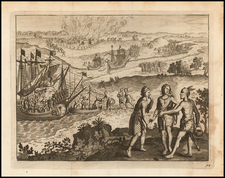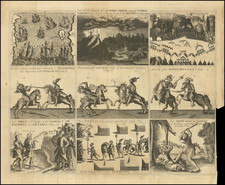Flaming Arrows By Nightfall
Fascinating depiction of one group of Indian Warriors attacking a neighboring village by nightfall.
The image shows a nightly revenge campaign conducted by Florida Indians. The text translates as follows:
The Ostes, motivated by a desire for revenge, sometimes arrive at night with the utmost possible silence to scout whether the guards are overwhelmed by sleep. If they find them to be so, they approach the rear of the town and, using dried moss tied to the tips of their arrows as per their custom, set them on fire and shoot them into the town. Their aim is to set ablaze the roofs of the houses, made of palm fronds and dried by the summer heat. Upon seeing the burning roofs, they flee as quickly as possible before the inhabitants notice. They run so quickly that it is difficult to catch up with them. Moreover, the fire provides enough trouble for the residents to free themselves and take action. These are the warlike stratagems of the Indians for destroying enemy towns. However, the damage is relatively light, since it costs only labor to rebuild new houses.
The engravings published by Theodor de Bry in his Grand Voyages (1591) are based upon watercolor illustrations made by Jacques Le Moyne de Morgues, are the earliest known European depictions of Native Americans in what is now known as the United States. Le Moyne, a member of the short-lived French colony known as Fort Caroline founded by Huguenot explorer Rene Goulaine de Laudonniere (ca. 1529-1574), based the watercolors on his experiences in Florida in the 1560s. De Bry later published Le Moyne's work, along with other illustrations of the New World, as part of an effort to encourage European colonization in the Americas. Jacques le Moyne de Morgues, an illustrator and explorer, sailed with René de Laudonnière on the 1564 Huguenot expedition to Florida. Laudonnière set up Fort Caroline on the St. John's River in 1564, but the settlement was destroyed by the Spanish army under Pedro Menendez de Aviles.
De Bry's Engravings of the Florida Indians
For his Grands Voyages, De Bry engraved 42 plates based Le Moyne's original sketches made during the French Huguenot voyage to the Florida Peninsula. De Bry's renderings of Florida and its inhabitants are today the earliest known printed European images of Native Americans in present-day Florida, known as the Timucua Indians.
The images attempt to convey a number of messages about the land and its peoples. For example, some of the plates have been suggested to represent the ability of the Timucua to obey authority and that they are less sophisticated than the Europeans. This was argued to make them ideal candidates for French Huegonot colonization, to be used in conflicts against Catholic Spain.
The accuracy of De Bry's depictions have sometimes been called into question. Some of the engravings do not quite match what became known about the Timucua by later French explorers, and some engravings possess out-of-place features, such as the appearance of a Pacific nautilus rather than a Florida whelk shell. However, it is believed that the core of the imagery is correct. For example, the depiction of Timucuan body art, otherwise unknown to Europeans at the time, suggest that De Bry's depictions were grounded in reality.
Theodor de Bry (1528-1598) was a prominent Flemish engraver and publisher best known for his engravings of the New World. Born in Liege, de Bry hailed from the portion of Flanders then controlled by Spain. The de Brys were a family of jewelers and engravers, and young Theodor was trained in those artisanal trades.
As a Lutheran, however, his life and livelihood were threatened when the Spanish Inquisition cracked down on non-Catholics. De Bry was banished and his goods seized in 1570. He fled to Strasbourg, where he studied under the Huguenot engraver Etienne Delaune. He also traveled to Antwerp, London, and Frankfurt, where he settled with his family.
In 1590, de Bry began to publish his Les Grands Voyages, which would eventually stretch to thirty volumes released by de Bry and his two sons. The volumes contained not only important engraved images of the New World, the first many had seen of the geographic novelties, but also several important maps. He also published a collection focused on India Orientalis. Les Grands Voyages was published in German, Latin, French, and English, extending de Bry’s fame and his view of the New World.









![A New and Exact Map of the Dominions of the King of Great Britain on ye Continent of North America . . . [Beaver map]](https://storage.googleapis.com/raremaps/img/small/101277.jpg)



![(Colonial East Florida) [Letter From Thomas Bond in St. Augustine, East Florida, September 14, 1770 to his Father, John Bond, Merchant of Fells Point, Baltimore County, Maryland]](https://storage.googleapis.com/raremaps/img/small/86621.jpg)
![[ Native Mexican Warrior ] Ein Mexicaner](https://storage.googleapis.com/raremaps/img/small/94089.jpg)